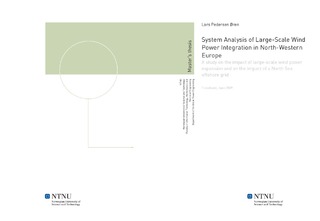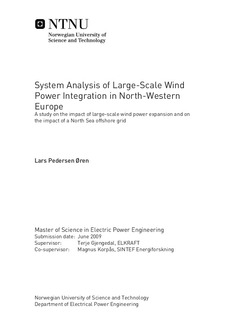| dc.description.abstract | Problem description: The objective of this project was to create a simple model of the European power system and to investigate the effect an increasing amount of on- and offshore wind power will have on the North European power market in general and Norway in particular. The scenarios contain increasing amounts of installed wind power capacity, both on- and offshore. Emphasis was to be on the area surrounding the North Sea. The project covers the following issues: - Simulations of simplified power system scenarios set in the years 2005, 2020 and 2030. - Study how an increasing amount of installed wind power will affect energy prices, power production distribution, and power transmission flows. - Investigate how an offshore grid consisting of interconnections between offshore wind farms will affect the system. The task: The simulations in this project were performed using simple power market model. The model included 6 price areas: Denmark West, Denmark East, Norway, Sweden/Finland, Germany and UCTE/Others. The existing market model was modified in the following manner: - Split Norway into three price areas: Norway North, Middle and South - Add the Netherlands - Add the United Kingdom - Add corresponding offshore price areas for areas neighbouring the North Sea. Wind series were generated for each wind generator using reanalysis data. Scenarios were created for the years 2005, 2020 and 2030. In these scenarios, wind power capacities are increasing as time progresses. The 2020 and 2030 scenarios have been simulated with two alternative grid configurations: one where the offshore areas are connected only to their respective onshore areas and one where the offshore areas are also interconnected in an offshore grid. In total 7 different scenarios were simulated. Results: Wind power is able to supplant a large share of energy originally produced by con-ventional thermal generators. The presence of an offshore grid does not have any dramatic effects on energy production for the system, though it is possible to conclude that the presence of an offshore grid may contribute to slightly shift the power system in favour of renewable energy sources. Wind power will cause a significant reduction in energy prices in all areas, resulting in reduced energy costs for the entire system. Analysis of lost wind and hydro power reveals the importance of sufficient transmission capacity when large quantities of wind power are added to the system. Scenario 4 features enormous quantities of lost hydro power in the North and Middle of Norway due to transmission limitations. Analyses of power transmissions reveal that the offshore grid is over-dimensioned. Rationalizing the grid by reducing transmission capacities to more realistic levels will give a more cost-effective solution. This was demonstrated by performing a quick simulation and analysis of a scenario featuring such a rationalized grid. Wind power will cause more frequent variations in hydro power generation, due to balancing needs. Parts of the increased variability in the hydro generators can be explained by the increasing amount of wind power in the system, while other parts are most likely caused by limitations in the simulation model itself. Conclusion: Given the number of assumptions made in the grid, in cost calculations and in the model at large, it is more important to focus on general trends than on concrete numerical values. However, it is clear that increasing the amount of on- and offshore wind power in the European power system will have a beneficial impact to society's energy costs. It is also clear that wind power has the potential to dramatically reduce CO2-emissions caused by power generation. The offshore grid seems to be more beneficial to the power producers than to consumers since it causes slightly higher energy prices and providing a measure of flexibility as to where offshore wind power production is sent. Wind power will present challenges, especially regarding transmission grid development. A sufficiently dimensioned grid will be essential to the successful implementation of such amounts of wind power, both with respect to profitability and in order to avoid waste of potential wind or hydro energy. | nb_NO |

